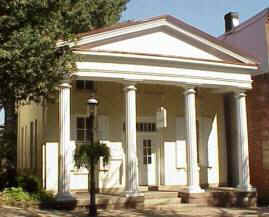 |
Joshia Hart Bank
________________________________________________________________________

Joshia Hart Bank
In nineteenth-century America, a popular and patriotic opinion held that our new nation embodied the democratic ideals of ancient Greece. The Greek Revival style was inspired by Greek architecture, and by the new Greek democracy. Many of the public buildings in Washington, DC were built in the Greek Revival style, which was adopted throughout the country. In the United States the style was popularized by the architects Benjamin Latrobe (1764-1820) and Robert Mills (1781-1855) in Washington, and by William Strickland (1788-1854) in Philadelphia.
Some characteristics of Greek Revival style are – gabled portico, pediments supported by Greek columns, recessed entrance, low or flat roofs, painted white and symmetrical plan
__________________________________________________________________________________________
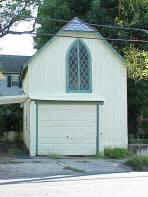
Saint
Paul’s Episcopal Church
Gothic Revival was the earliest of the Victorian styles. It was very different from those preceding it, which had been symmetrical and inspired by classical forms. This style was inspired by medieval architecture, especially castles and churches.
Some characteristics of gothic revival
style are steeply pitched roof, pointed arch windows and doors, oriel windows
bay windows, verandah and balcony, chimney pots and asymmetrical plan
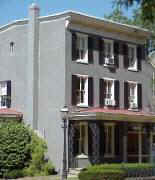 |
The Italianate style was inspired by the country villas of northern Italy. Unlike the typical American country homes of earlier eras, which were painted white, Italianate houses were often in colors which echoed the grass, rocks and trees of their surroundings.
Italianate structures sometimes featured cast-iron railings and facades, especially on commercial buildings..
Some characteristics of the Italianate style are low-pitched or flat roof, large eave brackets under the roof , tall, arched windows with hoods or "eyebrows" tall, angled bay windows , large panes of glass in doors, long porches or arcades and cast-iron railings and facades , two or three stories (rarely one story), rectangular plan, sometimes square
Romanesque
Revival
________________________________________________________
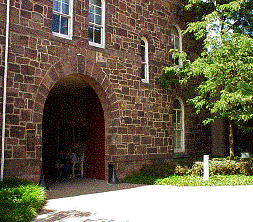
asymmetrical plan
The Romanesque Revival was inspired by medieval French and Spanish Romanesque architecture. Its masonry construction, massive walls and semicircular arches made this an expensive house to build. For this reason it was popular as a style for private homes only among the very wealthy, and was primarily confined to public buildings such as hospitals, jails and schools, and sometimes row houses
Some characteristics of the Romanesque Revival style: monochromatic stone finish, monochromatic stone finish, arched windows and doors, monumental, massive appearance and asymmetrical plan
_______________________________________________________________________________________________
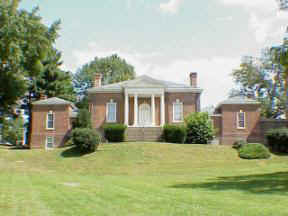
Elkins Gallery
The Colonial Revival style was inspired by architecture from the Georgian and Adam periods in America.
BACK
TO HOME PAGE
Some characteristics of the Colonial Revival style: large portico
entrance, paired windows, windows with double-hung sashes, multi-pane glazing
columns, porticos, fanlights, Palladian windows and rectangular shape